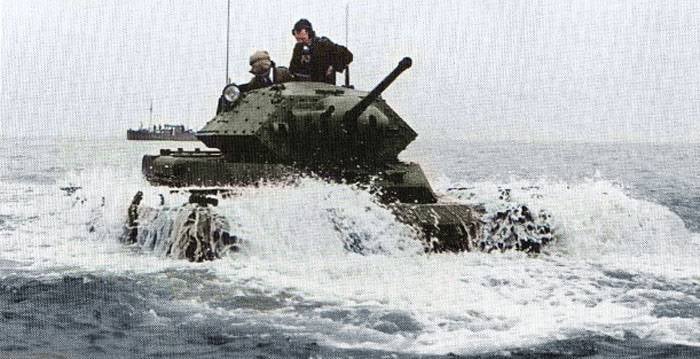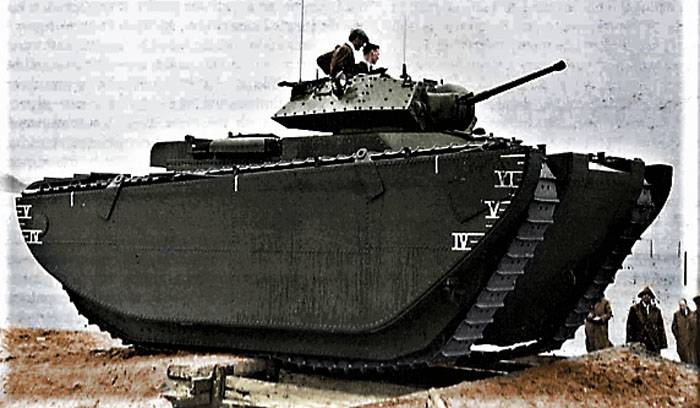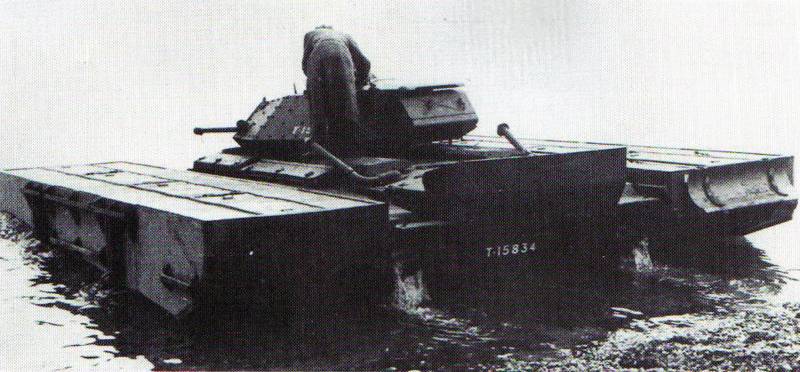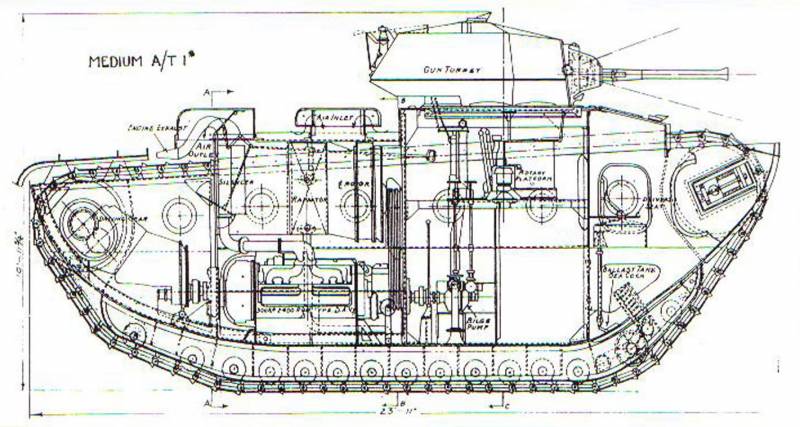A / T 1 amphibious tank (UK)
Water obstacles have a negative impact on the speed of the attack, and therefore the troops need different boats, as well as armored vehicles capable of navigating through water without help from others. At the very beginning of the forties, the British military and engineers began to look for ways to turn existing armored vehicles into floating ones, and special attention was paid to the newest cruiser tank Cruiser tank Mk V, also known as A13 Mk III Covenanter.

Experienced tank A / T 1 * on trial
Initially, the designers have worked the easiest option to ensure buoyancy. The tank was equipped with large floats, which allowed it to float. The movement was carried out by rewinding tracks. A “covenanter” with special equipment could work on water, but the actual characteristics turned out to be insufficient. It was clear that the floats have no real prospects. Other, bolder solutions were required.
Soon there was a new proposal, which allowed to solve all the main tasks. It was necessary to develop a new combat vehicle, originally adapted for work on land and on water. At the same time in its design it was possible to widely use components and assemblies of the serial tank A13 Mk III. Thus, a promising machine could show high performance on the water, but at the same time have the firepower of a Covenanter tank.
The new draft of the floating armored vehicle received the official designation Medium Tank A / T 1. In the future, the project was finalized and changed, which was reflected in its index. In accordance with the traditions of that time, new projects were designated as A / T 1 * and A / T 1 **. No additional project name was assigned.
For the amphibious tank A / T 1, a completely new hull with a chassis had to be developed. The power plant and transmission could be taken from the existing cruising tank. The Covenanther was also asked to borrow a tower with weapons and some of the other equipment. Despite the use of ready-made units, a promising medium tank had to differ in its original appearance with characteristic “sea” contours.
It was proposed to make chassis armament chassis from individual rolled sheets and assemble them with rivets. In terms of protection, the new hull was similar to the hull of the A13 Mk III tank. Frontal details of such a body had a thickness of up to 40 mm and provided protection against bullets and shells. Other parts were less thick. The roof and bottom were made of 7-mm sheets. To obtain the required buoyancy margin, the hull must have a greater height. It used the classic tank layout. A large manned compartment was placed in front of the hull, conventionally divided into a command and control compartment. In the center and the stern of the power plant units were located.
The hull of a promising tank had “seaworthy” lines. So, he received a large curved lower frontal part, installed with a significant inclination forward. The sides of the hull-boat were formed by protruding sponsons of large sizes, around which caterpillars stretched. Outside, the undercarriage was covered with an additional flap of a polygonal shape. The lower forage sheet was also curved and improved water flow.
The upper front hull sheet was installed with a large slope back. Directly behind it was a relatively small under-turret box with a sloping front end. The roof of the hull behind the combat compartment consisted of horizontal sheets placed at different heights. It provided several covers for different devices.
The turret for the A / T 1 was borrowed from a serial cruiser tank. Its dome was made of several armor plates of various shapes and sizes, forming a polygonal structure of medium height. In the front sheet of the tower there was an installation for mounting weapons. Part of the upper sheets was a hatch cover. Under the dome of the tower remained a basket with fixtures for the necessary devices.
In the central part of the hull, with a shift backward, they placed the Meadows DAV gasoline engine with 340 horsepower, borrowed from the base tank. The transmission units were also taken from the existing equipment, however they were supplemented with new devices. In the transmission included an additional gearbox with two modes of operation, designed for movement on the water and go ashore. Such a transmission was associated with driving wheels in the rear.
Special tasks of the machine led to the emergence of a specific undercarriage. In front of the hull, at high altitude above the ground, were placed the guide wheels with a spring tension mechanism. Similarly, in the stern placed drive wheels. It was proposed to install 16 small diameter track rollers on the bottom of each side sponson. In the first version of the project, all rollers were fixed on the body rigidly. The upper branch of the caterpillar lay on supporting rollers located on the roof of the sponson.

A / T1 amphibious tank under test
For some reason, the floating tank did not receive a separate propulsion unit for navigating through the water. Swim offered by rewinding tracks. There was also no specialized steering system. Maneuvers should be carried out by changing the speed of movement of the tracks. However, the car did not remain without special "sea" equipment. Inside the frontal part of the hull placed ballast tank. When sailing she had to compensate for the weight of the engine in the stern. In addition, when launching or coming ashore, ballast could be used to move the center of gravity backward or forward. So, when going ashore, a loaded nasal tank increased the load on the front of the tracks and improved traction with the ground.
To increase the total volume of the hull and, accordingly, improve buoyancy, mounted floats have been developed. These products differed in large size and occupied almost the entire side projection of the machine. At the same time, they were relatively narrow. The floats were fixed on the hull side sponsons.
In the Medium Tank A / T 1 project, a borrowed turret was used, which affected the composition of the tank’s weapons. The main weapons The machine became the 40-mm gun Ordnance QF 2 pounder. She could accelerate shells up to speeds of the order of 1280 m / s and had an effective range of fire up to 1000 yards. The most effective projectile at such a range punched up to 57 mm of homogeneous armor. With the gun was paired 7,92-mm machine gun Besa. Horizontal targeting was carried out by turning the entire tower and providing shelling targets in any direction. Vertical guidance was performed within a smaller sector.
The crew consisted of five people. In front of the hull, under his own hatch, there was a driver. Behind him, under the protection of the tower, the commander, gunner and loader worked. The fifth crew member was a flight engineer and was supposed to work inside the armored hull. He had to monitor the operation of the engine and transmission. While on the water, the engineer was also responsible for the ballast tank and kept the tank "on an even keel."
The A / T 1 machine, having a special hull-boat, was supposed to differ not in the smallest dimensions. The length was 7,3 m, the width along with the floats was more than 3,9 m. The height of the tower’s roof reached uncharacteristic for the tanks of that time 3,4 m. The combat weight was 31 t. Despite this weight, the tank could swim. However, a significant weight, as well as the absence of a soft suspension, reduced the mobility of the machine on water and on land. The maximum speed could not exceed several tens of kilometers per hour.
In 1942, the British industry built an experienced Medium Tank A / T 1 for testing. Inspections on land were carried out at one of the landfills in Surrey. Sea trials were planned to be carried out in South Wales, near Barry Island. Already the first tests showed that the experimental machine did not fully meet the requirements and could not yet show the calculated characteristics.
Initially it was assumed that the tank would be able to reach speed on land up to 20 miles per hour (about 30-32 km / h), but the actual performance was noticeably lower. The reasons for this were the imperfect design of the power plant and chassis. The engine, located deep inside the hull, quickly overheated under load, and the stiff suspension seriously hampered the work of the crew. As a result, at a certain stage of testing, a proposal appeared to improve the project.
An improved tank called A / T 1 * should have been equipped with new means of supplying air to the engine radiators. In addition, it was decided to simplify the transmission. Now she was a copy of the Covenanther devices. Finally, it was proposed to modify the chassis. Several front road wheels, hung over the ground, got a simple spring suspension. It absorbed some of the impact energy and to some extent simplified overcoming obstacles. Soon, the existing experienced tank was repaired and upgraded by a new project. Then he was again brought to the test.
After the adjustment, the characteristics of the A / T 1 * improved slightly, which made it possible to proceed to the tests on the water. During these checks in the first place, it turned out that the tank had an insufficient reserve of buoyancy: only the tower and the turret box remained above the water surface. The caterpillars again showed themselves to be not the best propulsion unit on the water. The absence of a ship-type steering wheel also became a problem. By rewinding the tracks, the upgraded tank could reach speeds of no more than 5 miles per hour (about 8 km / h).
For all its flaws, an experienced amphibious tank had a significant advantage over other equipment. He combined the possibility of crossing water bodies by swimming and tank armament with serious protection. However, the ratio of the pros and cons of the design was clearly not in favor of the tank.
Taking into account the results of the second stage of testing, another design update was carried out. This version of the tank was designated A / T 1 **. The main difference of this project was the use of the Synchro-Self-Shifting system from Sinclair as part of the transmission. It simplified gear changes and reduced the load on other units. In addition, the project “**” provided for various technological changes.
As far as is known, the existing experienced Medium Tand A / T 1 * did not refine the new project. The proposed upgrade improved individual characteristics, but did not have a decisive influence on the parameters of the machine as a whole. First of all, the processing of the transmission could not increase the reserve of buoyancy, and besides, it did not affect the weapons complex. Thus, the modernization of the existing prototype for the new project did not make sense.
Some sources mention the elaboration of another project, designated by three asterisks at once. However, detailed information about the floating tank A / T 1 *** is missing. Perhaps this project did not exist at all, and information about it is the result of some confusion. However, even if this project was developed, a prototype of the new model did not appear.
In 1943, there was a special situation that determined the real future of the amphibious tank A / T 1. First, the tests of the prototype showed that its tactical and technical characteristics are far from ideal and do not allow to effectively solve the tasks. Secondly, the further development of the existing project did not make sense. To get rid of existing shortcomings required a radical processing of the entire machine.
Finally, the Covenanter tank service influenced the prospects for the floating armored vehicle. By the end of 1943, this technique finally lost its potential. The cruiser tank had insufficient protection and was not distinguished by powerful weapons, which was why it could not fight on equal terms with modern German tanks. For this reason, some of the promising developments based on it did not have a real future. The "covenanter" ceased active service, and a number of new models at its base did not advance beyond the testing stage.
Not later than the start of 1944, the British command ordered the development of the A / T 1 tank be discontinued due to the lack of real prospects. The only built prototype, by that time refined according to the A / T 1 * project, soon set out to disassemble as useless. Nowadays it can be seen only in a few photographs. To the delight of armored vehicle lovers, some of the pictures went through a process of colorization.
The failure of the Medium Tank A / T 1 project had several consequences. The main one was that by the time of the landing in Normandy, the British army had no amphibious tanks. This to some extent complicated the planned landing operation, but did not have a fatal effect on it. The Allies were able to solve the tasks and without amphibious tanks in the UK.
Based on:
http://tanks-encyclopedia.com/
http://wwiivehicles.com/
https://shushpanzer-ru.livejournal.com/
https://forum.warthunder.com/
Fletcher D., Sarson P. Crusader, Cruiser Tank 1939 – 45. Osprey Publishing. 1995.


Information